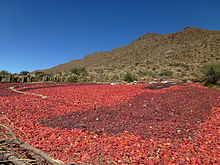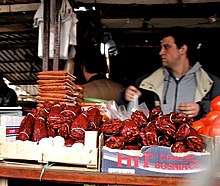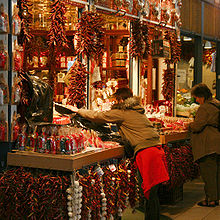Paprika





Paprika is a spice made from ground, dried fruits of Capsicum annuum, either bell pepper or chili pepper varieties or mixtures thereof. The seasoning is used in many cuisines to add color and flavor to dishes, but it is usually associated with Hungary, Spain, and Portugal, the latter two having introduced Capsicum annuum to the Old World from the Americas. It is also used in Turkey, Greece, Serbia, Croatia, Romania, Bulgaria, Morocco,[1]A major area of production is around Kalocsa in Hungary.
The use of this plant rapidly expanded from Iberia throughout Africa and Asia,[2] and ultimately reached Central Europe through the Balkans, which were under Ottoman rule, explaining the Slavic origin of the modern English term. In Spanish, paprika has been known as pimenton since the 1500s, when it became a typical ingredient of the western region of Extremadura.[3] Despite its presence in Central Europe since the beginning of Ottoman conquests, it did not become popular in Hungary until around over one hundred years ago.[4]
Central European paprika was hot until the 1920s, when a Szeged breeder found one plant that produced sweet fruit. This was grafted onto other plants.[5] Nowadays, paprika can range from mild to hot, and flavors also vary from country to country, but almost all the plants grown produce the sweet variety.[5] The sweet paprika is mostly pericarp with more than half of the seeds removed, whereas hot paprika contains some seeds, placentas, calyxes, and stalks.[3]
In many European languages, but not in English, the word paprika also or only refers to the Capsicum fruit itself.
Etymology and history
The plant that makes the Hungarian version of the spice was grown from 1529 by the Turks at Buda[6] (now part of the capital of Hungary, Budapest). The first recorded use of the word "paprika" in English is from 1896.[6] It came from the Hungarian word "paprika", which was a diminutive of the Serbo-Croatian word "papar" (meaning "pepper"),[6] which in turn came from the Latin "piper" or Modern Greek "piperi".[6] Similar words, "peperke", "piperke", and "paparka", are used in various other Slavic languages in the Balkans for bell peppers.[3]
The two Spanish varieties of Paprika, known in Spain as "Pimenton" come from the Comarca de la Vera in Caceres province and a variety from Murcia region, both of which were introduced from the Americas, where they originate, by local monks some time in the 1500s.
The word "Paprika" entered a great number of languages, in many cases probably via German.[7] Many European languages use a similar word whilst examples from other languages include the Hebrew paprika [פפריקה] and the Japanese papurika [パプリカ].[7] One folk etymology that is contradicted by linguist evidence is that paprika was named after the religious Hindu figure Rysh Paprike.[8]
Usage

Paprika is produced in a number of places including Hungary, Serbia, Spain and some regions of the United States.[9] It is used as an ingredient in a broad variety of dishes throughout the world. Paprika is principally used to season and color rices, stews, and soups, such as goulash, and in the preparation of sausages as an ingredient that is mixed with meats and other spices. In the United States, paprika is frequently sprinkled on foods as a garnish, but the flavor is more effectively produced by heating it gently in oil.[10]
Spanish Paprika (Pimentón) is available in three versions, mild (Pimentón Dulce), moderately spicy (Pimentón Agridulce), and very spicy (Pimentón Picante.) Some Spanish paprika, including Pimentón de la Vera has a distinct smokey flavor and aroma as it is dried by smoking, typically using oak wood.[11]
Hungary is a major source of paprika and is thus more commonly used. It is available in grades ranging as follows:
- Special quality (Különleges) the mildest, very sweet with a deep bright red color.
- Delicate (csípősmentes csemege) – color from light to dark red, a mild paprika with a rich flavor.
- Exquisite Delicate (Csemegepaprika) – similar to Delicate, but more pungent.
- Pungent Exquisite Delicate (Csípős Csemege, Pikáns) – an even more pungent version of Delicate.
- Rose (Rózsa) – pale red in color with strong aroma and mild pungency.
- Noble Sweet (Édesnemes) – the most commonly exported paprika; bright red and slightly pungent.
- Half-Sweet (Félédes) – A blend of mild and pungent paprikas; medium pungency.
- Strong (Erős) – light brown in color, the spiciest paprika.[12]
The Netherlands is a major production and distribution source of paprika as well, especially grown in greenhouses.
In Moroccan cuisine, paprika (tahmira) is usually found slightly moistened by the addition of a small amount of olive oil blended into it.
Paprika can also be used with henna to bring a reddish tint to hair when coloring it. Paprika powder can be added to henna powder when prepared at home.
Nutrition
Capsicum peppers used for paprika are unusually rich in vitamin C, a fact discovered in 1932 by Hungary's 1937 Nobel prize-winner Albert Szent-Györgyi.[13] Much of the vitamin C content is retained in paprika, which contains more vitamin C by weight than does lemon juice.[14]
The color of paprika is primarily due to the xanthophyll carotenoid zeaxanthin.
According to the USDA, 1tbsp (6.8g) of paprika has the following nutritional content:[15]
- Calories :19
- Fat : 0.88g
- Carbohydrates : 3.67g
- Fiber: 2.4g
- Protein: 0.96g
See also
References
- ^ Emmons, Didi, Vegetarian Planet: 350 Big-Flavor Recipes for Out-Of-This-World Food Every Day, p. 437
- ^ http://books.google.co.uk/books?id=SsjvX31EMekC&dq=%22a+paprika%22&q=portuguese+iberia#v=snippet&q=iberia%20portuguese&f=false
- ^ a b c Peppers: The Domesticated Capsicums, pp. 5 and 73
- ^ The Glutton's Glossary: A Dictionary of Food and Drink Terms, p. 205
- ^ a b Paprika: A Spicy Memoir from Hungary, p. 202
- ^ a b c d "Online Etymology Dictionary". Etymonline.com. Retrieved 2011-11-04.
- ^ a b Katzer, Gernot (May 27, 2008). "Paprika (Capsicum annuum L.)". Retrieved December 1, 2012.
- ^ Wong, Curtis. "Holešovice's Hungarian rhapsody". Retrieved 9 April 2012.
- ^ "Paprika — Food Facts". Food Reference. Retrieved 2011-11-04.
- ^ Hyde, Brenda. "Classic Spice Blends: Paprika". Oldfashionedliving.com. Retrieved 2011-11-04.
- ^ "Spanish Paprika — Pimentón". Spanishfood.about.com. 2011-03-02. Retrieved 2011-11-04.
- ^ by Tom (2008-10-31). "Grades of Paprika | The Spice House Blog". Retrieved 2011-11-04.
- ^ ": Szeged, 1931–1947: Vitamin C, Muscles, and WWII:". The Albert Szent-Gyorgyi Papers. U.S. National Library of Medicine. Retrieved 2009-04-22.
- ^ "Nutrition Facts Comparison Tool: Spices Paprika v. Lemon Juice Raw". Healthaliciousness. 2009. Retrieved 2009-07-27.
- ^ http://www.nal.usda.gov/fnic/foodcomp/search/
